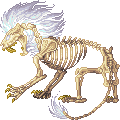




General
The Candle Archipelagos are busy come late fall, with preparations for the annual festivities well underway across the whole island chain. This time of year is special to a certain type of rare animal as well, a shy beast that visitors to the islands call the skellion. These large skeletal cats stalk down from the lush mountains on the most remote of the Archipelagos’ islands each year around this time, though their reason for doing so is yet unknown. They have only recently become known to the mainland, named less than a century ago in an anecdotal account by a shipwrecked naturalist. The Qaitu people know little about them as well, for the creatures are almost impossible to find during the rest of the year. They claim that these are not the living bones of lions, or any other known cat, but rather something much older, something which once held great power. The skellions, called nodolim by the Qaitu, never interact bother humans, but all the same, they are left a portion of the bones leftover from the feasts in reverence of their former role in the world.
Egg
A thin aura surrounds this egg.
Hatchling
As with many creatures in the Archipelagos, skellions seem to glow with an inner light. Though males are arguably brighter, and can be seen illuminated as skeletal figures many miles away, the darker females still look as though they are always lit, even on moonless nights. Skellions fear no other animal, and even hatchlings will wander around as they please, though in many ways they act less like ordinary hatchlings and more like miniature adults. They are silent, like their parents, and though interact with one another in what appear to be casual greetings, no one has ever seen a skellion play. Even at a young age they seem to ignore most other animals, perhaps because they do not eat, and cannot be physically harmed. If raised by humans, skellions behave much the same way, and will wander about with little regard for their human companion except on exceedingly rare occasions. They are often regarded as difficult to care for, as they do not reciprocate attempts to bond or socialize with humans or most other creatures.
Adult
Skellions can often be seen around water holes and on secluded beaches around late fall, when they make their way down the mountains and spend a few weeks in full sight before vanishing back to their unknown residences. Precious little is known about them, making skellions natural sources for academic interest. Their nonchalant attitude toward most living creatures exacerbates interest in them, as it means overly curious researcher can sit mere feet away and watch the cats for hours without risking anything but a bit of sleep. Eggs are exceedingly rare to find, but on the occasion that someone does cross a nest, the cats will do little more than stare critically at a nest thief before continuing on their way. As the eggs hatch mere hours later, and the young are able to care for themselves almost from their first moments, the adult skellions likely have no reason for concern if one of their eggs gets spontaneously adopted by an enthusiastic naturalist.
Notes
Obtained from: Donation (Oct)
Breeding: Yes
Renaming cost: 2000 gold
Release date: October 15th 2015
Element: Neutral 
Breeds with the following:
Skellion + Skellion = Skellion (Guaranteed) Cost: 3 shards
October 2015 Midmonth Donation Pet
Sprite art: Tekla | Description: PKGriffin